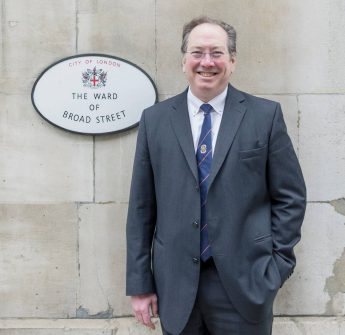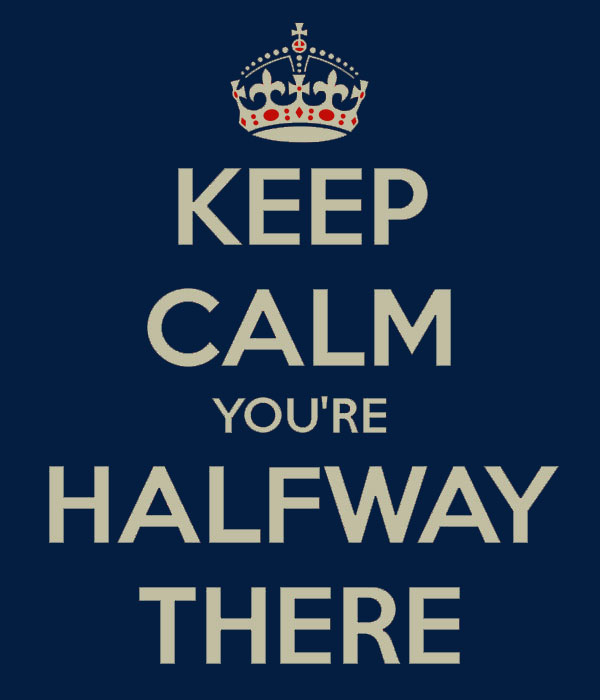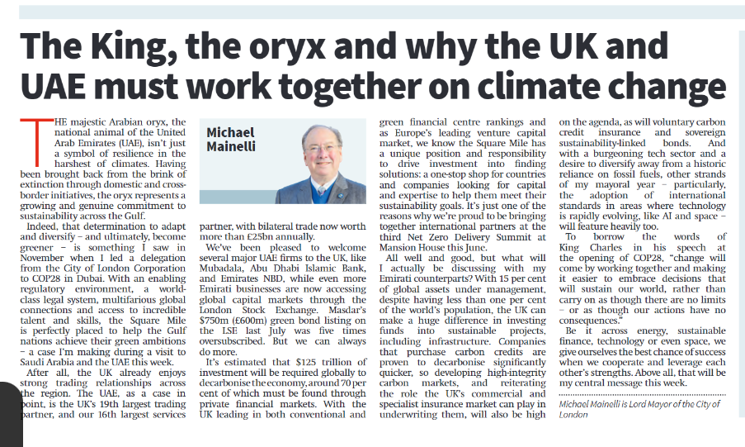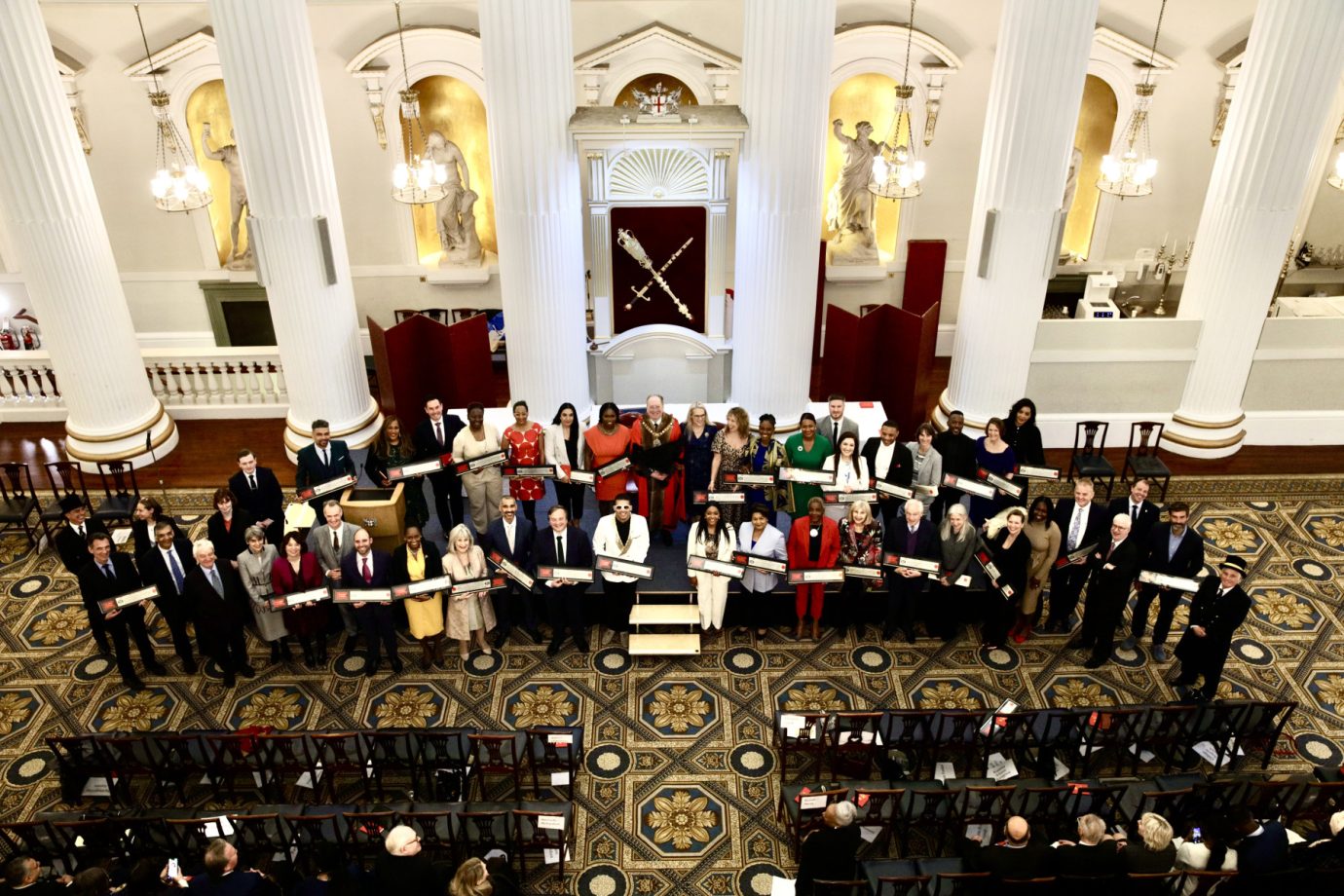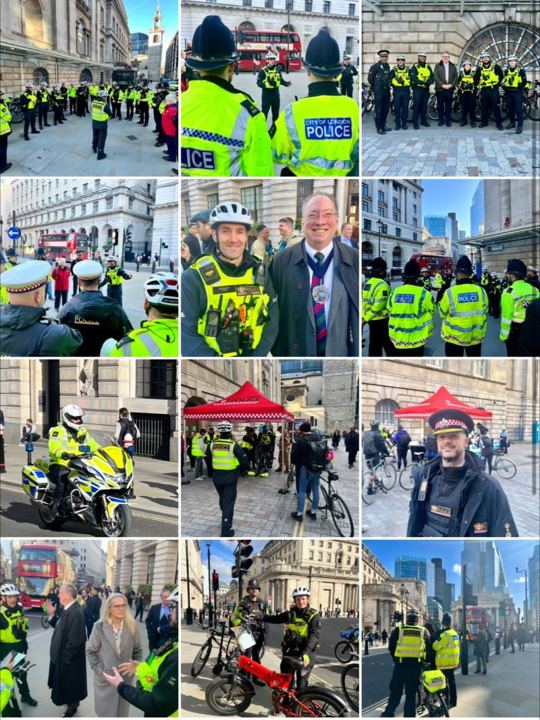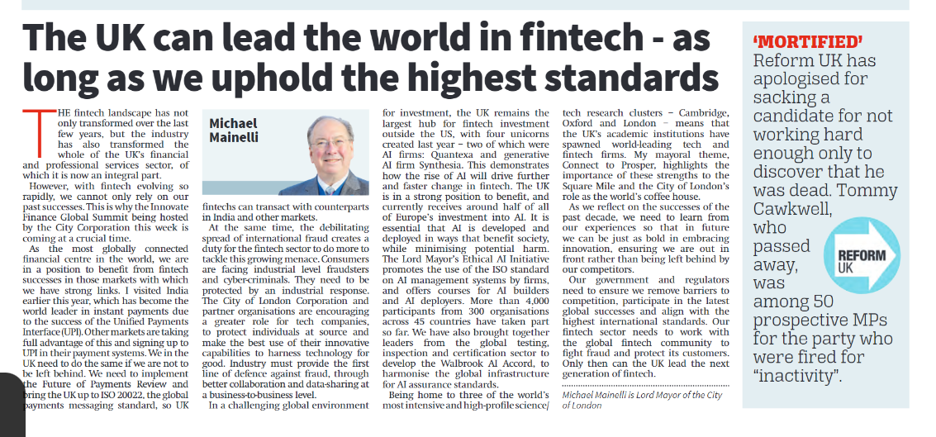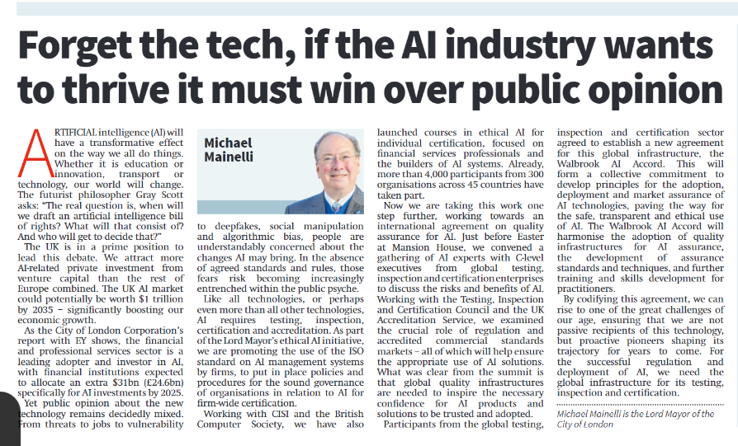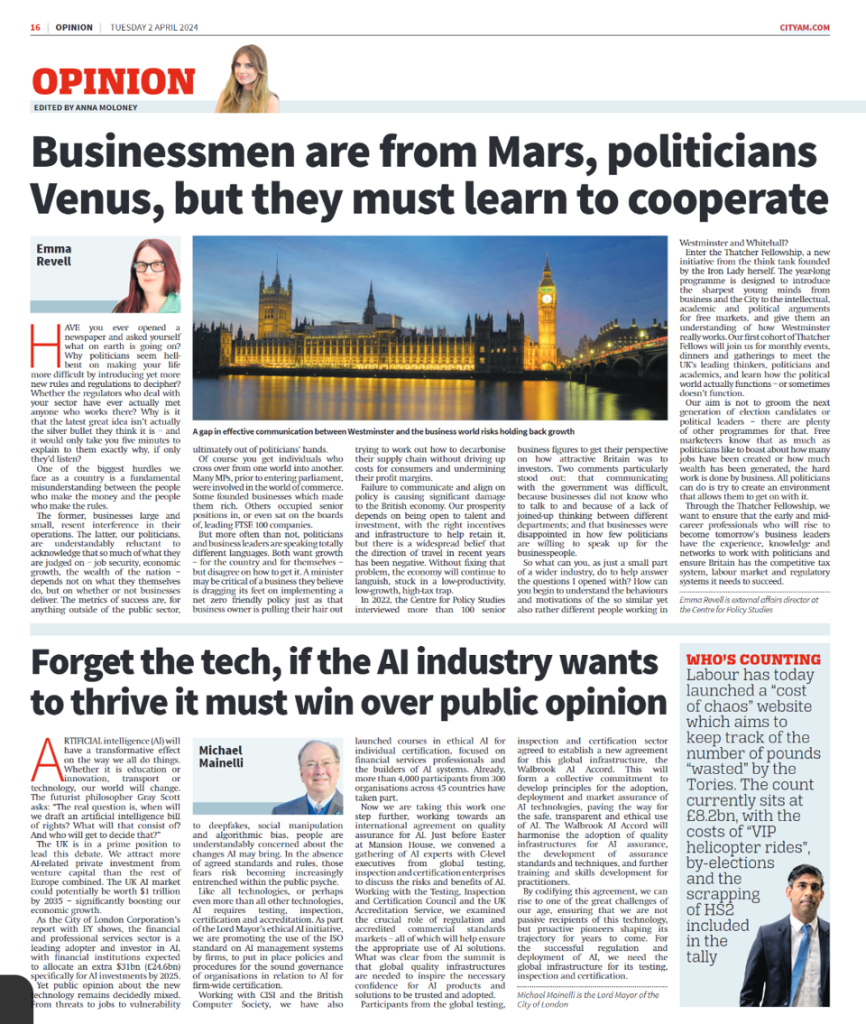Well, today is the one day this year when the staff at Mansion House and I are using the same number of days to mark the Lord Mayor’s term, 182. 26 weeks, with a leap day therein. I’ve been counting up to the mark of 365 days while the joke runs that “the team at Mansion House count in the opposite direction”. In truth, it’s been a great run so far, with fantastic support here at the Mansion House. Do feel free to evaluate the programme yourself – Connect To Prosper, and our May report card.
The City of London & Broad Street Ward
“Bright Lights, Open Minds, Robust Community”
Mayor’s Progress – May
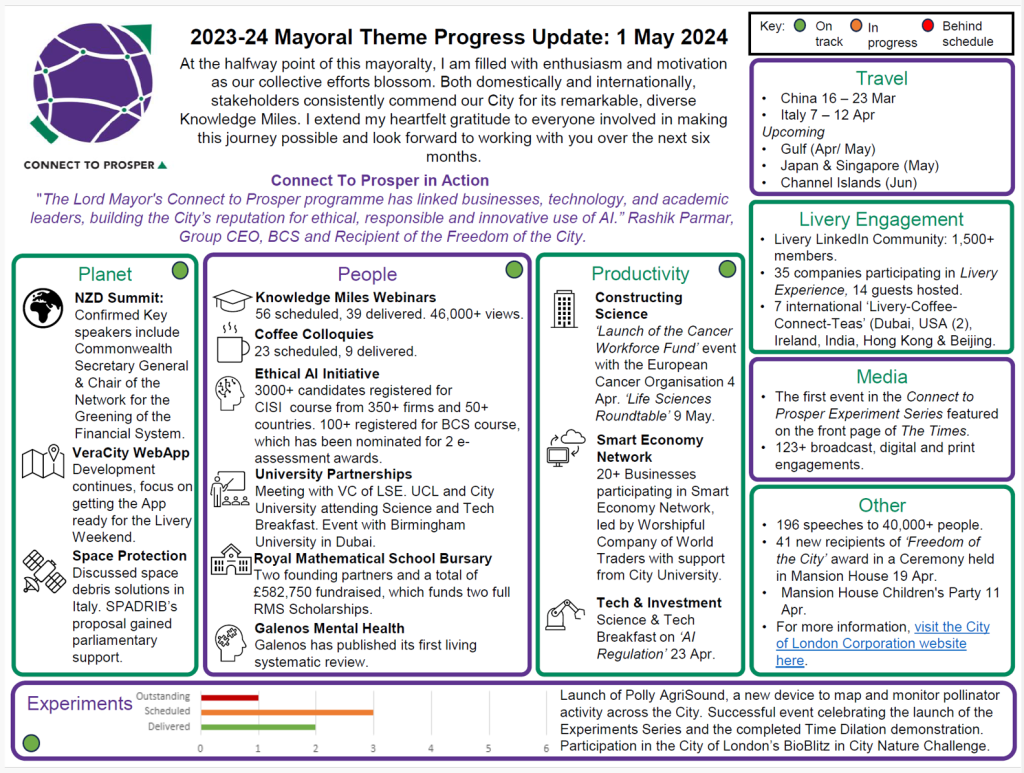
Article: The king, the oryx and why the UK and the UAE must work together to beat climate change
40 Remarkable Individuals Awarded Freedom Of The City Of London In Group Ceremony – Number 1
For the first time since 1899, dozens of people have been awarded the Freedom of the City of London today. The ceremony saw 40 recipients from a broad spectrum of sectors honoured at the Mansion House for their outstanding contributions in their respective fields.
Continue readingCycling – Less Manic, Less Panic
Sadly, as a cyclist myself, the anti-social behaviour of many London cyclists is becoming socialised. Thus we had an enforcement morning today from 08:00 to 10:00 at Bank with the following resources:
- City of London Police Cycle Team (1 sergeant & 7 constables)
- Neighbourhood Policing officers (NHP) and crime prevention stand
- Road Policing officers (with vehicle and solo motorcycle)
- Lorry/HGV for an Exchanging Places experience (sitting in a real state-of-the-art lorry cab to see what can’t be seen of the cyclists when driving)
- Cycle mechanic to carry out basic bicycle maintenance for commuters for free.
- London Fire Brigade – to explain dangers around e-bike battery storage.
- Corporation Road Safety Team
- Bike-register – security cycle marking for free (usually £20)
- Student officers positioned at junctions to pass on safety message to cyclists and explain why the roadshow is here and the benefits of attending
It was impressive to see squads of police trying to stop errant cyclists. My personal estimate is that far more than half ‘got away’, sometimes nonchalantly cycling round 50 or so cyclists and hi-vis officers at the King William Street lights, running those red lights, going up on pavements, cycling the wrong way down the street, and then evading waving police officers. There really is a problem.
Results? 129 cyclists were stopped and offered a ticket or attending a ‘road show’.
- 120 sent over and attended the road show – this was the main aim, so they were given option of ticket or attend road show
- 8 tickets (not bad considering all the police there and they had option of going to road show)
- 1 arrest (s24 PACE 19834 – as they refused to give details after contravening a red light)
- 7 e-bikes/e-scooters seized for destruction
- 44 bicycles security marked
- 200 plus key messages around cycle safety and crime prevention
Sadly, during the morning, just outside Bank, a woman was run over by an unregulated scooter and put into intensive care.
All partners that attended were pleased with the event, getting their own key messages out and thanked us for arranging the event. My sincere thanks to Deputy James Thomson (Chairman of the Police Committee), Commander Khan, and the entire Corporation and Police teams.
Media coverage:
https://www.standard.co.uk/news/crime/cyclists-fined-city-police-london-bank-junction-b1152140.html
https://road.cc/content/news/almost-1000-cyclists-fined-jumping-red-lights-307887
https://www.cyclingweekly.com/news/are-cyclists-who-jump-red-lights-really-the-problem
Plaque On Track
I was delighted with my first sign of plaque – no, not even dental is spelt “placque”! It was a delight to open a newly refurbished track in Parliament Hill. Great coverage too – “Parliament Hill athletics track on Hampstead Heath gets £2m revamp“.
Just before kicking off a race amongst some enthusiastic junior Harriers, my remarks went:
Parliament Hill Athletics Track official opening, Parliament Hill Athletics Track, Hampstead Heath, Wednesday, 17 April 2024, by The Rt Hon The Lord Mayor of London, Alderman Professor Michael Mainelli
Chair, Councillors, ladies and gentlemen…
I am delighted to be here to officially open the Parliament Hill athletics track after this renovation. Huge thanks to the Hampstead Heath, Highgate Wood and Queen’s Park Committee, the staff of the Environment Department and all those involved in the works.
I was going to start with a joke, but I didn’t want to do a running gag.
The City of London Corporation has managed Hampstead Heath since 1989. This is part of the more than 11,000 acres of open space in London and southeast England – which also include Burnham Beeches, Epping Forest and many more – in which we invest over £38million a year.
These open spaces, most of which are charitable trusts, are run at little or no cost to the communities that they serve. They include important wildlife habitats, Special Areas of Conservation, Sites of Special Scientific Interest, and National Nature Reserves – and they are protected by legislation. They are also part of the lungs of London, removing around 16,000 tonnes of carbon from the atmosphere every year. Hampstead Heath is one of our most iconic.
Parliament Hill = After a £2million investment in this site, these improvements to one of the country’s top athletics venues are now complete – ensuring this remains a key venue for national and international athletics events, and retains the prestigious UK Athletics Trackmark accreditation.
As well as being open to the public, this track is used throughout the year by several running clubs and schools from across north and central London, and is open to the public. In fact, 50 local schools use it for PE and sports days. And the running clubs here also have strong youth sections and encourage participation from local young people.
One such club is the Highgate Harriers, who hold their annual Night of the 10,000m PBs (Personal Bests) here. This popular sporting event – which has been running for more than a decade now – is free to attend and brings together elite runners from across the world to compete alongside some of Britain’s best athletes.
As well as the Olympic 10,000m trials, this year’s event in May will also host the British Championships and will be a designated World Athletics Silver Label event, attracting some of the best International elite athletes. Alongside all those PBs, this site is home to a record, when Mizan Adane of Ethiopia ran 10,000m in 29 minutes 59 seconds last year, the fastest time by any woman on a UK track.
I am delighted that we are joined today by a London Marathon winner and a 10,000m world record holder. I recently had the pleasure of meeting the City of London Corporation’s own ‘Mile 23’ Club who will be running the London Marathon this weekend – hopefully they will be among the people enjoying this renovated track in future.
I ran the London Marathon 21 years ago – but once was enough for me. You won’t see my running the course in my mayoral regalia – although I may suggest this for one of my successors. But everyone who does run it has my respect, and I wish them all the best of luck.
After the City worked so closely with the clubs who use this facility throughout the improvement works, we can be confident that the improved track will meet and exceed the needs of users for many years to come. In fact, I can say with certainty, it will be a runaway success.
My thanks and congratulations again to all those involved in the renovation and improvement of this great facility,
I look forward to unveiling the official plaque. Thank you.
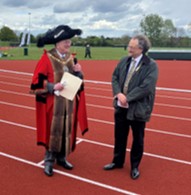
Article: How the UK can lead the world in fintech
“How the UK can lead the world in fintech” – City AM
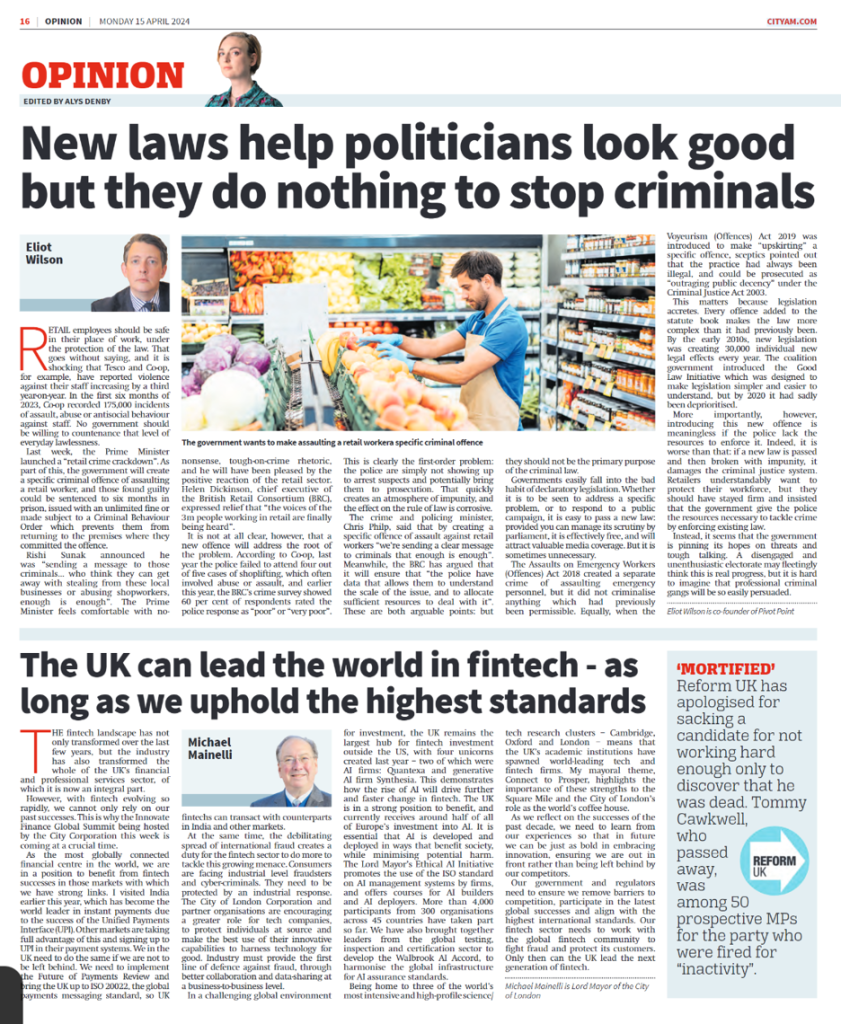
The Pinchbeck Waterloo Watch Draw
Pinchbeck Waterloo Watch draw for the Lord Mayor’s Big Curry Lunch, £20.
A unique watch – there will only ever be one Waterloo Watch – to raise funds to support veterans into employment. This beautiful, distinctive timepiece has been created in the workshops of the renowned watchmaker Harold Pinchbeck in Lincoln. The company was originally founded in the City of London in the eighteenth century. Every year from now on, thanks to the generosity of Paul Pinchbeck, his company will create a different watch to raise funds for the LMBCL. Each will take the name of a significant military event.
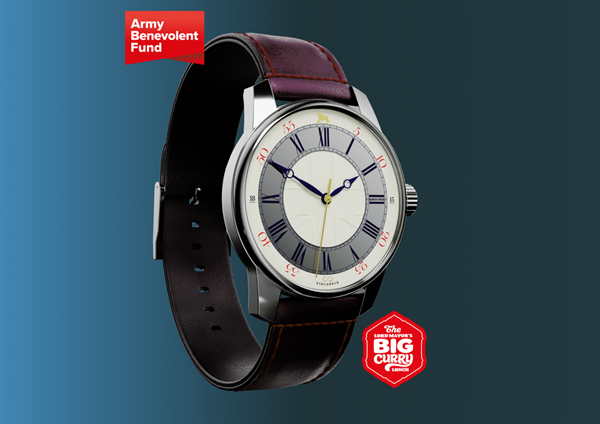
The Bees Needs
Great to attend the Pollinating London Together Annual General Meeting at Drapers’ Hall. My remarks went as follows:
Drapers’ Hall, 18:00, Tuesday, 2 April 2024, The Rt Hon The Lord Mayor of London, Alderman Professor Michael Mainelli
Ladies and Gentlemen.
It is my pleasure to join you this evening for the Pollinating London Together annual meeting. For those who don’t know me, I’m Michael Mainelli, the 695th – but first American-born – Lord Mayor of the City of London; a place I like to refer to as the world’s oldest democratic workers’ and residents’ cooperative.
I’ve lived in London for forty years but I’m still discovering new things. As a teenager I worked in a family bee business, but I’ve only just found out there’s a difference between the bees we have in America and the ones here in the UK. A UK bee carries pollen. A US bee carries data.
So, hands up, I admit it, I’m also fond of a good dad joke. What’s a bee’s favourite hairstyle? A buzz cut. How about their favourite book? The Great Gats-bee. OK, I’ll stop droning on and get to the important bits.
I’m sure you don’t need me to tell you how valuable the work you do to support pollinators and their habitats is. But it has been an absolute pleasure to work with Pollinating London Together on various strands of my “Connect To Prosper” theme, on a shared journey to a greener, brighter future.
As many of you know, “Connect To Prosper” seeks to leverage the incredible power of the City’s unique connections to tackle huge global challenges, the most important of which is combatting climate change and biodiversity loss.
The City of London Corporation has been playing its part for years now. We were the first government body to introduce a clean air act in 1953. And we’re on track to reach net zero in our own operations by 2027 while supporting net zero for the whole Square Mile by 2040 and helping the City unlock its full potential as a one-stop-shop for sustainable finance.
In November, the Policy Chairman, Chris Hayward, and I represented the City at COP28 in Dubai. On June 4th we’ll host the annual Net Zero Delivery Summit, where we’ll take stock of progress made at the mid-way point between Dubai and Baku.
Meanwhile, last month I was pleased to host the launch of the City carbon credit cancellation service, C4S, alongside the Livery Climate Action Group. Throughout the year we’re holding “Coffee Colloquies” where thought-leaders can discuss the big issues of the day, and you might be interested in the Royal Society’s colloquy on “Monitoring Nature” on April 16th.
We’re also shining a spotlight on the Square Mile’s various “Knowledge Miles” with an online lecture series delivered by City organisations, livery companies and educational institutions. And I want to express my utmost thanks to Pollinating London Together for the update on your work on February 15th and lecture on greenspaces alongside the Gardeners on March 26th.
As well as being a leading centre for financial and professional services, the City is also a global hub for innovation. To demonstrate this, we recently launched our “Connect To Prosper” experiment series and I’m so pleased that one of our experiments is a pollinator count with Pollinating London Together on July 1st.
Everyone who lives or works in the City has a role to play in pollinator conservation, and the City of London Corporation takes that very seriously. As you know, we have hosted two carefully maintained beehives at Mansion House for many years. However, recognising that the City’s high number of managed honeybees places pressures on wild pollinators, we have also invested in a roof garden and better window box planting to provide more forage.
More widely, we’re encouraging all City businesses to green their premises and create habitat for pollinators where they can. And we’re working to improve the urban environment for pollinators with new plantings in public spaces and the creation of nesting habitats for wild bees.
Ladies and Gentlemen – I started this year with an ambition to encourage more cooperation among key City organisations. And Pollinating London Together is the group I find myself holding up as a great example of that pan-City working. Thank you, once more, for all you do for the City and our precious planet!
I’ll leave you with a little tale you might appreciate. A man walks into a dentist’s surgery and says: “Help! I think I’m a moth!” “Then you need a psychiatrist, ” the dentist replies. “I am seeing a psychiatrist,” says the man. “What are you doing here then?” the dentist asks. “Well,” the man replies, “your light was on.”
Thank you.
